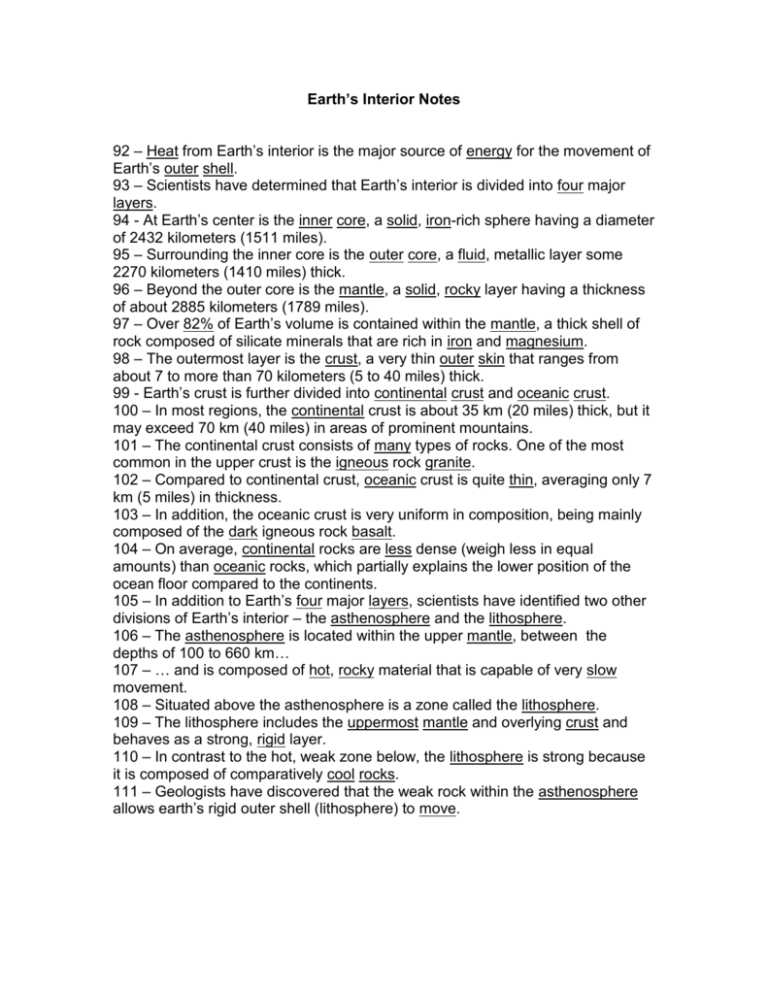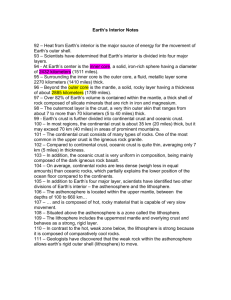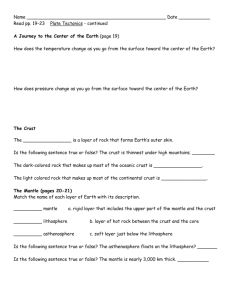Earth`s Interior Notes Key
advertisement

Earth’s Interior Notes 92 – Heat from Earth’s interior is the major source of energy for the movement of Earth’s outer shell. 93 – Scientists have determined that Earth’s interior is divided into four major layers. 94 - At Earth’s center is the inner core, a solid, iron-rich sphere having a diameter of 2432 kilometers (1511 miles). 95 – Surrounding the inner core is the outer core, a fluid, metallic layer some 2270 kilometers (1410 miles) thick. 96 – Beyond the outer core is the mantle, a solid, rocky layer having a thickness of about 2885 kilometers (1789 miles). 97 – Over 82% of Earth’s volume is contained within the mantle, a thick shell of rock composed of silicate minerals that are rich in iron and magnesium. 98 – The outermost layer is the crust, a very thin outer skin that ranges from about 7 to more than 70 kilometers (5 to 40 miles) thick. 99 - Earth’s crust is further divided into continental crust and oceanic crust. 100 – In most regions, the continental crust is about 35 km (20 miles) thick, but it may exceed 70 km (40 miles) in areas of prominent mountains. 101 – The continental crust consists of many types of rocks. One of the most common in the upper crust is the igneous rock granite. 102 – Compared to continental crust, oceanic crust is quite thin, averaging only 7 km (5 miles) in thickness. 103 – In addition, the oceanic crust is very uniform in composition, being mainly composed of the dark igneous rock basalt. 104 – On average, continental rocks are less dense (weigh less in equal amounts) than oceanic rocks, which partially explains the lower position of the ocean floor compared to the continents. 105 – In addition to Earth’s four major layers, scientists have identified two other divisions of Earth’s interior – the asthenosphere and the lithosphere. 106 – The asthenosphere is located within the upper mantle, between the depths of 100 to 660 km… 107 – … and is composed of hot, rocky material that is capable of very slow movement. 108 – Situated above the asthenosphere is a zone called the lithosphere. 109 – The lithosphere includes the uppermost mantle and overlying crust and behaves as a strong, rigid layer. 110 – In contrast to the hot, weak zone below, the lithosphere is strong because it is composed of comparatively cool rocks. 111 – Geologists have discovered that the weak rock within the asthenosphere allows earth’s rigid outer shell (lithosphere) to move.





